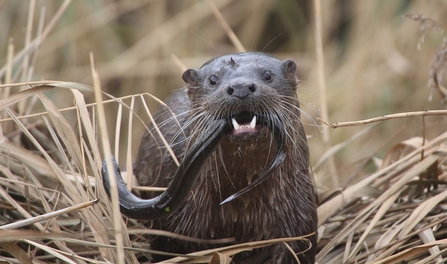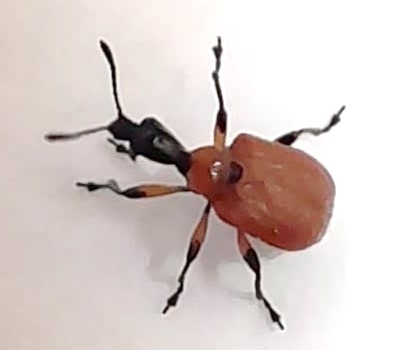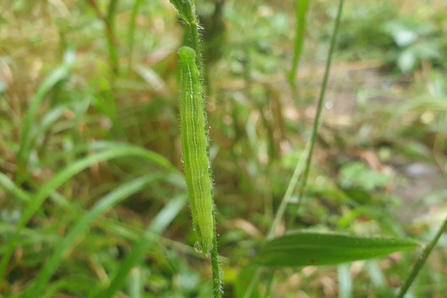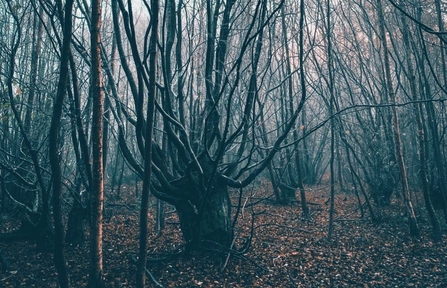Weekly wild news from our reserves – 29 October 2021
Curlew at Hen Reedbeds – Gavin Durrant
This otter almost bit off more than it could chew when it caught an eel at Carlton Marshes.

Otter and eel at Carlton Marshes - Andrew Easton
Spectacular skies
Suffolk’s skies are stunning at this time of year, especially when there are curlew overhead.
Lemmy lookalike
The bearded tit is a small bird with a long tail that is mainly found in large reedbeds like those at Redgrave & Lopham Fen where this photograph was taken by Richard Gornall during the week. Reedbed provides food in the shape of insects and reed seeds. The bearded tit also builds its nest low down among the reeds, often on piles of dead reed stems. Males are noticeable by sight with their distinct cinnamon-brown hues, long, brown tail, grey head with a black 'moustache' (rather than a beard) and a yellow bill and eyes. Females are less colourful than males, and do not have the moustache. Bearded tits can be heard calling with a nasal 'ting' or 'ping' sound as they fly about the reeds. The bearded tit is also known as 'bearded reedling' or 'bearded parrotbill'. In fact, it is not actually a tit or parrotbill, but has now been assigned to its own family.
Bearded tit - Richard Gornall
Easterly drifting kite
This red kite was seen soaring across Mickle Mere Nature Reserve this week prompting some video footage of its distinctive features, namely the arched wings and long and deeply forked tail. With a white head and white patch on the under wing and a distinctive silhouette, they are absolutely beautiful. Although the red kite may not be breeding in high numbers in Suffolk yet, the fact they are being seen more frequently and in greater numbers is a mark of the success of a reintroduction programme that saw red kites from Sweden and Germany released in the Chilterns, the Midlands and the north of Scotland during the 1990s. The programme was designed to bring this magnificent bird, once common across the British Isles, back from the brink. Persecuted during Victorian Times, red kites became extinct in England in the 1930s when there were just 10 pairs left in a remote part of Wales. By the mid-1980s, there were still less than 100 pairs across the UK. Red kites were common in Shakespearean London, where they fed on scraps in the streets and collected rags or stole hung-out washing for nest-building materials. Shakespeare even referred to this habit in 'The Winter's Tale' when he wrote: 'When the kite builds, look to lesser linen'. The nest of a red kite is an untidy affair, often built on top of an old crow's nest. It is lined with sheep's wool and decorated with all kinds of objects like paper, plastic and cloth.
Hazel leaf-roller weevil
The eye-catching hazel leaf-roller weevil Apoderus coryli is found in woodland, hedgerows, parkland, and wherever the host plants are found. After mating in early summer the female cuts slits into leaves (mainly hazel) and rolls them up into cigar-shaped cylinders or ‘cradles’. She then lays 5 or 6 yellowish eggs inside via a hole made with a snout-like projection on her head called a rostrum.

Hazel leaf-roller weevil – Alex Lack
Speckled wood caterpillar
The speckled wood butterfly is a common and widespread butterfly of woodland edges and rides, where it flies in the dappled sunlight, and can also be seen in hedgerows and gardens. Adults feed on honeydew, while the caterpillars feed on a variety of grasses, including false broom and cock's-foot, like this one seen at Reydon Wood.

Speckled wood caterpillar at Reydon Wood – Daniel Doughty
Red deer stag
This red deer stag is becoming a regular sight at Dingle Marshes. The red deer is the UK's largest deer. Males have large, branching antlers, increasing in size as they get older. During the autumnal breeding season, known as the 'rut', males bellow to proclaim their territory and will fight over the females, sometimes injuring each other with their sharp antlers. A single calf is usually born the following spring.

Red deer – Jamie Smith
Bleeding beefsteak fungus
Wildlife is thriving on the root plate of the giant fallen oak at Hutchison’s Meadow, proving the value of leaving dead wood in situ where possible. The hornets' nest is still active and this awesome ‘bleeding’ beefsteak fungus has appeared just in time for Halloween!
Spooky hornbeam
Following on the Halloween theme, we love this spooky ancient hornbeam at Reydon Wood!

Hornbeam at Reydon Wood – Sarah Groves






